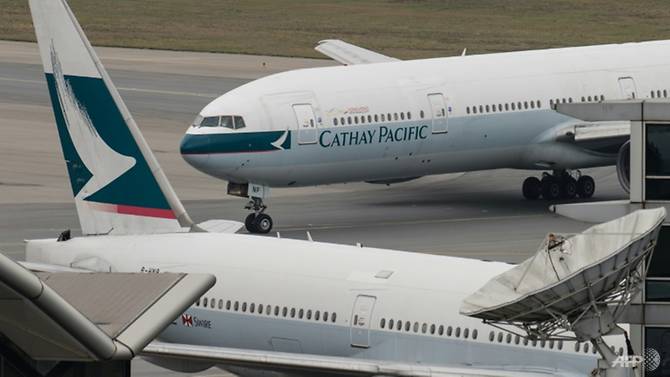Troubled Cathay loses US$262 million in first half 2017
 |
| Hong Kong flag carrier Cathay Pacific reported a massive net loss of HK$2.05 billion for the first half of the year as the airline struggled with intense competition from rivals. (Photo: AFP/Anthony Wallace) |
The results, which were worse than analysts predicted, came after Cathay saw its first annual loss in eight years in 2016, as lower cost Chinese carriers eat into its market share.
Wednesday's results pave the way for the first ever back-to-back annual losses in the company's 70-year history.
Bloomberg analysts had forecast a year-on-year loss of HK$1.2 billion (US$153 million) for the first half of 2017.
Chairman John Slosar described the results as "disappointing" to reporters and said competition was the most significant factor.
Companies like China Eastern and China Southern Airlines are offering direct services to Europe and the United States from the mainland, while budget carriers like Spring Airlines have targeted regional travellers, undermining Cathay's position.
The airline is also losing premium travellers as it comes under pressure from Middle East rivals which are expanding into Asia and offering more luxury touches.
That has led to promotional prices for Cathay's top tickets as they are sold to leisure travellers.
The airline said passenger revenue decreased by almost four per cent, with passenger yield - the average amount paid per passenger per mile - dropping 5.2 per cent.
"Demand for air travel continues to grow, which is good, but capacity growth has outstripped demand growth in many of the key markets that we serve," Slosar told reporters.
Higher fuel prices, including the cost of hedging, a strong Hong Kong dollar and rising aircraft maintenance costs also weighed on Cathay, Slosar said, as did fines from the European Commission over the airline's cargo surcharges.
Fuel was the biggest cost, up 12.7 per cent year on year from HK$13.26 billion to HK$14.94 billion, Cathay said in a statement to the Hong Kong exchange.
That reflected a rise in fuel costs and consumption, even though hedging losses had been reduced, it said.
Oil hedging is when an airline locks in prices of fuel at a pre-determined level for a certain amount of time.
TURBULENT FORECAST
Founded in 1946, Cathay has only reported annual losses three times, including in 2016, according to Bloomberg.
Last year's annual loss prompted a management shake-up and promises to slash staff costs by 30 per cent.
Current CEO Rupert Hogg took over in May, replacing Ivan Chu, who had been in the job for three years.
Cathay said in May it would cut 600 staff including a quarter of its management, as part of its biggest shakeup in two decades to repair its bottom line.
Slosar said Wednesday there were no further announcements on job losses.
Analysts said they expected no quick turnaround for the airline.
Cost cutting would be key, said analyst Jackson Wong of Huarong International Securities, who also said Cathay should abandon its hedging policy.
But Dickie Wong of Kingston Securities said the airline would also have to reinvent itself and provide a better quality experience to customers.
"If we talk about the service and the food quality of the economy class, it's just like a budget airline," Wong, a long-time Cathay flier, said.
He forecast challenges would continue, although he predicted the effects of the firm's cost cutting could pick up in the second half of 2017 and 2018.
"We do not expect the operating environment in the second half of 2017 to improve materially," Slosar said.
What the stars mean:
★ Poor ★ ★ Promising ★★★ Good ★★★★ Very good ★★★★★ Exceptional
Latest News
More News
- Major railway requires debt considerations (November 21, 2024 | 12:07)
- Reviving a new life cycle for plastic waste (November 21, 2024 | 09:16)
- Key balances maintained for industrial production (November 21, 2024 | 08:00)
- Ecolean Vietnam honoured with prestigious sustainability award (November 19, 2024 | 10:01)
- HEINEKEN Vietnam’s clear path towards net-zero (November 18, 2024 | 15:13)
- VLCA 2024 honours corporate governance excellence as listed companies raise the bar (November 18, 2024 | 09:00)
- High-tech personnel to drive competition (November 17, 2024 | 09:21)
- Rising use of Generative AI Apps boosts consumer interest in differentiated connectivity (November 16, 2024 | 09:41)
- Google supports shape of Vietnam’s AI future (November 15, 2024 | 19:49)
- Trump's trade policies could shape Vietnam's economic outlook: Dragon Capital (November 15, 2024 | 16:56)


















 Mobile Version
Mobile Version